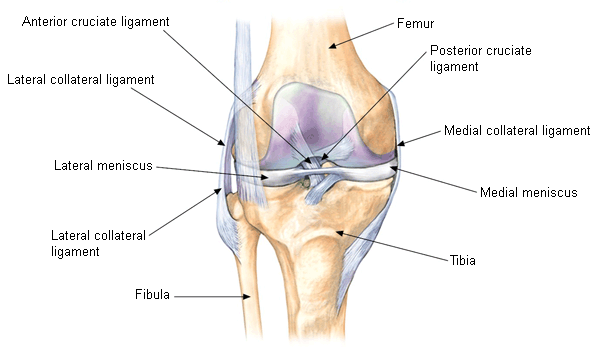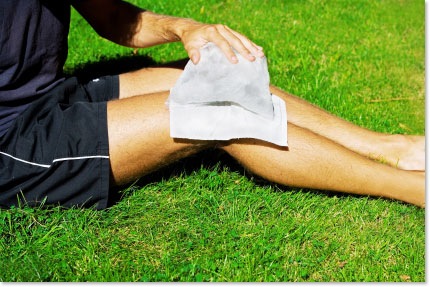Ligament Sprains
- Home
- Knee
- Common Ailments
- Ligament Sprains
There are 4 main ligaments supporting the knee all of which can be sprained. The most commonly sprained is the Medial Collateral Ligament (MCL), which is on the inside of the knee.
The other ligaments are the Lateral Collateral Ligament (LCL) (on the outside of the knee) and the Anterior and Posterior Cruciates (inside the knee).
Sprains generally occur with twisting or slipping injuries and can range from mild to severe.

The MCL is a thick ligament that attaches from the femur (thigh) to the tibia (shin) over the inside of the knee joint. It is strong and fans out and has a small attachment to the medial meniscus. It protects the knee joint from excessive twisting and pressure applied from the outside of the joint. The LCL is on the outside of the knee and attaches onto the femur and the fibula. It is a ropelike shape and protects the knee again pressure applied to the inside of the knee. Posterior Cruciate Ligament (PCL) injuries are rare and often occur in severe injuries where other structures are likely to be involved, for example in a car crash. ACL injuries are discussed its own section.
All ligaments are vital in providing information to the brain about balance and which muscles need to be working during every activity. After a sprain these receptors may be damaged and require specific balancing exercises to recover. This is essential to prevent recurrence of the injury in the future.

Ligament injuries around the knee occur when the ligament is stretched beyond its limit. This may result in a few fibres being torn or the whole ligament separating apart. It usually happens with a twisting or slipping injury or after landing awkwardly.

- The person may report hearing or feeling a ‘pop’ or tearing sensation at the time of the injury.
- Pain. Ranging from mild to very severe usually around the ligament that has been injured.
- Swelling. In the more severe sprains swelling can happen immediately making it difficult to move the knee. Some injuries may not swell until over night and others may not swell at all.
- Giving way. This may happen due to pain or swelling affecting the ability of the muscles to work or because the ligament has been so torn that is in unable to support the joint. Advice should always be sought if this occurs.
- Pain going up or down stairs, walking or turning over in bed are just a few examples of the activities that can be painful with a ligament sprain.

It is important to try and use the knee is normally as possible. This helps the healing process and also prevents causing strain on other muscles/ joints within the body. Basic exercises (link to basic exes sheet) can be attempted after 1 or 2 days either independently or after guidance from a physiotherapist if the pain is more severe.
The pain should gradually improve over 3 weeks as the ligament repairs. If this is not happening it is important to get help and advice from your GP or physiotherapist.
More severe tears need assessing by a physiotherapist or Orthopaedic Consultant as they may need immobilising in a special knee brace or surgical intervention.
If you sprain a knee ligament twice in a short period it is advisable to have a physiotherapy assessment. This is to assess if the balance receptors need specific exercises or if the strength had failed to recover fully.

